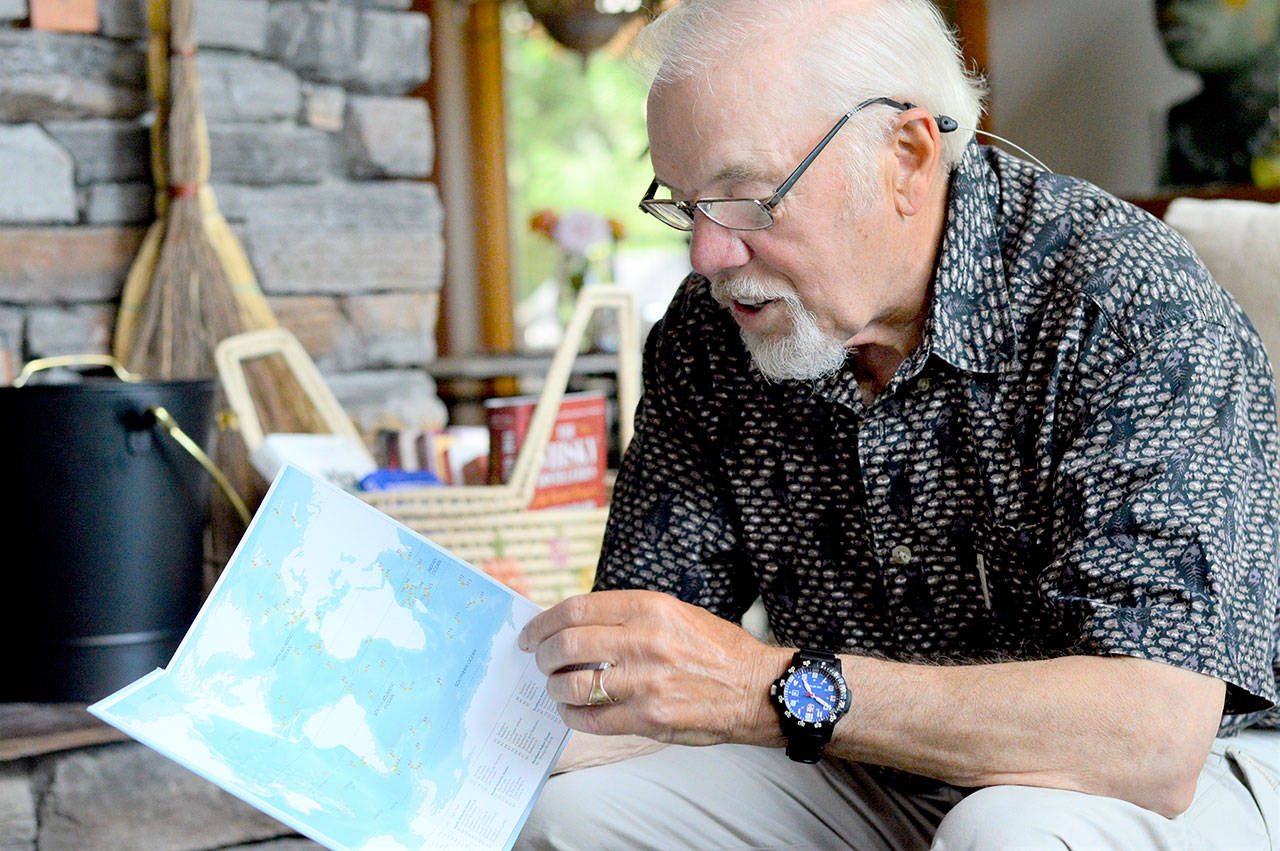PORT HADLOCK — The imposing limestone building where he grew up was “very Dickensian,” Peter Harrison remembers.
It was the British Seaman’s Orphan Boys Home in Brixham, a fishing town in southwest England.
Harrison, a longtime Port Hadlock resident and an expedition travel guide, lived at the orphanage in the 1950s.
His father and mother had both died young. But Harrison carries a vivid memory of a present his dad, who served in the Royal Navy, brought home from a year at sea.
Binoculars.
The 10-year-old Harrison cried when he opened the gift.
Later, at the boys’ home, he was a creative one, playing at sketching.
“My drawings were so bad,” he recalled, “but eventually I got better.”
That part of the world is known for its gales — and the waves of seabirds, cruising, high and full of grace, above the ocean.
“They enthralled me,” then and now.
After the orphanage, Harrison went to school to become an architect. For a few years in the 1970s, he designed British embassy buildings, but the work wasn’t for him.
One morning in November 1972, he had a realization: I’ve got to get out of here.
At age 23, Harrison sold his house in London, bought a land rover and set out on the 50-year adventure that brought him to this point.
With his wife, fellow adventurer and guide Shirley Metz, Harrison cofounded Apex Expeditions, a Seattle-based company that makes trips to Antarctica, the Galapagos, Seychelles and Australia, among other places.
“Shirley is an absolute star,” an explorer in her own right, Harrison said.
For the past year and a half, there have been no such trips. COVID-19 has kept Harrison and Metz home in Port Hadlock, in their house surrounded by forest, overlooking Oak Bay.
Now he’s finished a long-delayed project: the 600-page “Seabirds: The New Identification Guide.”
In it is a world of albatrosses, shearwaters, murres, cormorants, tropic birds, gannets, boobies, pelicans, puffins, penguins and petrels.
Harrison co-created illustrations for the book’s 239 color plates. He works in watercolor: “A dangerous mistress, but I’ve learned to dance with her,” he quips.
Contributing to the enormous project were Swedish artist Hans Larsson, who completed the artwork for the gulls, terns, skimmers, skuas and seaducks — 93 of the plates — and ornithologist and author Martin Perrow, who added structure to the text, tightening up the taxonomy and integrating new seabird research.
Thirty-eight years ago, Harrison published “Seabirds: An Identification Guide,” and has since authored a dozen other books and received multiple honors for his conservation work.
But he considers this “New Identification Guide” to be his ultimate work.
“This book would not have been finished were it not for COVID,” Harrison said.
“I look at COVID in a different way,” as a remover of obstacles to publishing “A New Identification Guide.” The book holds illustrations of some 435 species of seabirds — some of which Harrison has admired this summer off the shores of Sekiu and La Push.
Among them are the brown pelicans, known for their spectacular plunge dives. The brown and Peruvian pelicans execute those, he said, thanks to their powerful vision and the air sacs under their skin, which inflate, giving the bird extra buoyancy, just before it hits the water surface.
On his website, peterharrisonseabirds.com, Harrison provides links to photos and other artwork, information about Apex Expeditions trips scheduled later this year and, of course, the online store where his books are available.
In his living room, holding a copy of “The New Identification Guide,” the author paused.
This is his life’s work, a heavy book in his hands.
Then Harrison looks up.
“The thing that turns me on is how seabirds adapt,” to conditions around the globe, he said.
He added that seabirds are the most threatened bird group in the world. Like humans, their survival depends on the health of the oceans.
“We’ve lost three species since we started this book 15 years ago,” the author said.
“Extinction is forever; it’s the black abyss.”
As Harrison has traveled, he’s partaken in conservation work across the globe. He was invited to Buckingham Palace to receive an MBE, a member of the Order of the British Empire, from Queen Elizabeth II, and received the Royal Society’s Conservation Gold Medal and the New York Linnaean Society’s Eisenmann Gold Medal Award for Excellence in Ornithology.
He hopes people will read books such as “The New Identification Guide” and see the need to actively care for the planet’s resources.
Seabirds, to Harrison, are a magnificent signifier of earth’s condition.
“We will only have seabirds,” he said, “if we keep the ocean pristine.”
________
Jefferson County senior reporter Diane Urbani de la Paz can be reached at 360-417-3509 or durbanidelapaz@peninsuladailynews.com.

